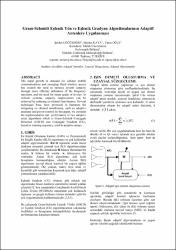| dc.contributor.author | Göğüsdere, Şevket | |
| dc.contributor.author | Kaya, Haydar | |
| dc.contributor.author | Oğuz, Yasin | |
| dc.date.accessioned | 2014-09-18T13:24:07Z | |
| dc.date.available | 2014-09-18T13:24:07Z | |
| dc.date.issued | 2002 | |
| dc.identifier.uri | https://hdl.handle.net/20.500.12440/443 | |
| dc.description.abstract | The rapid growth in demand for cellular mobile
communications and emerging fixed wireless access
has created the need to increase system capacity
through more efficient utilization of the frequency
spectrum, and the need for better grade of service. In
cellular systems, capacity improvement can be
achieved by reducing co-channel interference. Several
techniques have been proposed in literature for
mitigating co channel interference, such as adaptive
antennas and power control. In this paper, we consider the implementation and performance of two adaptive array algorithms which is Gram-Schmidt Conjugate Direction (GSCD) and Conjugate Gradient (CG), based on training sequence, used in adaptive arrays. | en_US |
| dc.language.iso | tur | en_US |
| dc.publisher | ELECO | en_US |
| dc.rights | info:eu-repo/semantics/openAccess | en_US |
| dc.subject | [No Keywords] | en_US |
| dc.title | Gram-Schmidt Eşlenik Yön ve Eşlenik Gradyan Algoritmalarının Adaptif Antenlere Uygulanması | en_US |
| dc.type | article | en_US |
| dc.relation.publicationcategory | Makale - Ulusal Hakemli Dergi - Kurum Öğretim Elemanı | en_US |
| dc.department | Fakülteler, Mühendislik ve Doğa Bilimleri Fakültesi, Elektrik - Elektronik Mühendisliği Bölümü | en_US |
| dc.contributor.institutionauthor | Oğuz, Yasin | |


















